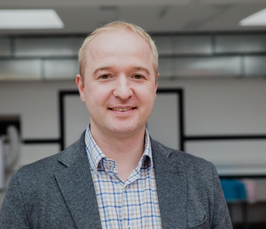Bound states in the continuum: from quantum mechanics to nanophotonics
Institutskolloquium
- Datum: 06.08.2021
- Uhrzeit: 10:30 - 12:00
- Vortragender: Prof. Andrey Bogdanov
- Andrey Bogdanov is an assistant Professor at ITMO University (St Petersburg, Russia). He is the leader of the group “Theoretical Nanophotonic”. Andrey graduated with honor from St. Petersburg State Polytechnical University in 2009. In 2012 he got a Ph.D. degree in solid-state physics at the Ioffe Insitute. His scientific interest lies in the field of nanophotonics, nonlinear optics, nanoresonators, optical forces, surface electromagnetic waves, metasurfaces, and bound states in the continuum. Andrey Bogdanov has authored more than 100 journal papers some of them entered the 1% of the most cited papers in physics in 2020. He was awarded a number of different prized, scholarships, and grants including the “Young Scientist Award” from the European Optical Society, the Leonard Euler Prize, and the award for young scientists of the Russian Academy of Science. Andrey has a huge teaching experience. He gave his first lectures on mathematical physics being a bachelor's student. He is the author of three online courses with more than 20 000 participants. Now, Andrey is the head of the international Master's program on “Nanophotonics and Metamaterials” at ITMO University. Andrey is the chair of the annual international summer school on “Nanophotonics and Metamaterials”.
- Ort: Zoom Meeting Room 1
- Raum: Zoom Meeting
- Gastgeber: Dmitry Moseev
- Kontakt: dmitry.moseev@ipp.mpg.de

Realistic simulations of electromagnetic turbulence are of crucial importance to understand and predict behavior of burning plasmas before they become experimentally available. Burning plasmas are complex systems with multiple spatial and temporal scales. Electromagnetic turbulence is ubiquitous in such plasmas. It is the basic component of the ``scenery'' involving the fast-particle dynamics, the global Magneto-Hydrodynamical and Alfvenic activity, zonal flows, and transport. The saturation of the electromagnetic turbulence is a consequence of a complex interplay between these components. A single numerical first-principle framework, based on the global gyrokinetic electromagnetic formulation and including self-consistently all parts of the problem, is needed. An approach to this task based on the gyrokinetic particle-in-cell codes will be addressed in the presentation. Electromagnetic simulations are known to be very challenging for the gyrokinetic particle-in-cell codes because of the numerical stability issues related to the cancellation problem [1]. Such simulations are also very time consuming since the fast electron dynamics has to be resolved. We address the numerical stability problem using the pullback mitigation technique [2,3] for the cancellation problem. Very long simulation times normally required when the electron dynamics is resolved are substantially accelerated deploying GPUs. In our talk, we will discuss the challenges and describe results of the global gyrokinetic modelling in the electromagnetic regime. [1] Physics of Plasmas, 24(8):081206, 2017 [2] Physics of Plasmas, 21(9):092110, 2014 [3] Computer Physics Communications, 238:194–202, 2019
Bound state in the continuum is an illustrative example of how a very simple concept suggested about a century ago in quantum mechanics was found the huge development in many fields of physics related to wave phenomena like hydrodynamics, atomic physics, acoustics, and nanophotonics. In this talk, I will review the history, mechanisms, examples of bound states in the continuum in photonics, and discuss their application.